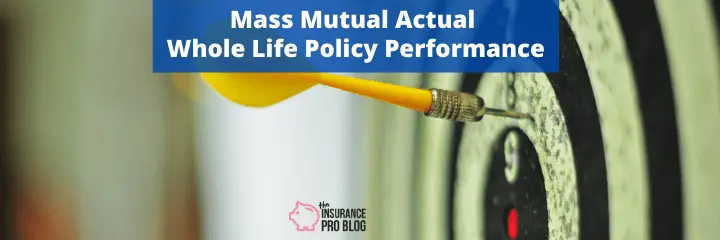Podcast: Play in new window | Download
Continuing our series of reviewing real-life results from whole life insurance policies, we look this week at MassMutual. Similar to other policies reviewed, we took data from a MassMutual whole life policy purchased around 10 years ago. We have the original illustration and used that to compare against current policy values.
We also used this data to look at the dividends currently payable to the MassMutual policyholder compared to originally projected dividends.
MassMutual Whole Life Policy Actual Cash Value Performance
We're looking at a MassMutual whole life policy that used all the critical elements of a policy designed to optimize cash value growth. It's blended with the majority of the premium comprised of paid-up additions.
This policyholder paid premiums exactly as originally planned. While this isn't critical to evaluating projected versus actual results since we can use internal rate of return (IRR) to control for changes, we did note in the Guardian review that changes in the actual premium paid probably affect the rate of return to a slight degree. Here's what we learned:
Originally, the policy projected a 4.65% annualized rate of return at this point in the policy. This means the policy owner anticipated earning 4.65% compounding annually on the premiums paid to the policy. The policy purchase took place about 10 years ago. The dividend rate at MassMutual declined from around 7% at inception to 6% today. The real IRR achieved on this policy is from inception is 2.97%.
Actual Historical Dividends Paid By MassMutual
While I don't have a detailed breakdown of each annual dividend payment from the policy outset, I can see the current dividend paid compared to the projected payable dividend from the original illustration. They are not surprisingly different.
The current dividend paid is 42% lower than the originally projected dividend payable at this point.
We can see that this lower dividend certainly drives down cash value performance from what the policyholder originally anticipated. It's also worth noting that while the change in dividends isn't as substantial as we saw in reviewing other companies, the change in cash value IRR is more pronounced. This point supports our long-standing claim that whole life insurance is a broad name used for a type of life insurance that can vary considerably from company to company when it comes to specific functionality.
Reasons The Policy Performed As It Did
The use of paid-up additions places less significance on the dividend payment with respect to the development of cash value. This is especially true for the first several years of a whole life policy's existence. The guaranteed interest paid on cash value, which applies to cash value created by PUA's, drives a considerable amount of policy growth during this time. So the change in cash value growth due to the dividend changes is less when looking at the overall performance of the policy.
Had this whole life policy used a more traditional design and approach to whole life insurance, it's extremely likely the change in IRR would be significantly more.
The Timing of Dividend Changes Matters
While this MassMutual whole life policy certainly under-performed its original projections, the dividend performance moving forward could lead to a wildly different story over the next 10 years.
If the dividend remains mostly the same, then the spread between actual and projected values will grow. This is simply the mathematical reality of the difference between the initial accumulation assumption and current realities. If on the other hand the dividend increases over this time, actual results will pull closer to projected values. What's easy to overlook in a life insurance ledger is the role the timing of dividend changes plays on cash value performance. When the policy has more cash value, changes in the dividend will be more impactful.
This knife cuts both ways, however. A whole life policy with a larger cash value balance will get a considerable boost when the dividend goes up, but it will also miss out on a lot of growth when the dividend goes down.
The MassMutual dividend did change quite substantially since policy inception, and this results in a policy with a lower than planned rate of return. There are about $25,000 fewer dollars in the policy than originally assumed.
That said, this policy still performed better than some of the other policies we reviewed even some that performed much closer to their projected values.


Can you please clarify the following statement you have made?
A whole life policy with a larger cash value balance will get a considerable boost when the dividend goes up, but it will also miss out on a lot of growth when the dividend goes down.
Why would a policy with larger cash value miss on growth when the dividend goes down, and relative to what situation – the initial illustration, or a 100% base whole life policy?
Hi Jay, miss to the original illustration. The comment is highlighting a sequence of returns risk issue. So if the dividend declines early on and then rebounds, the impact on overall cash value accumulation is minor. If the opposite occurs (dividend doesn’t decline until later in the policy’s life) the absolute loss in accumulated cash value will be more assuming the same average movement in the dividend scale.